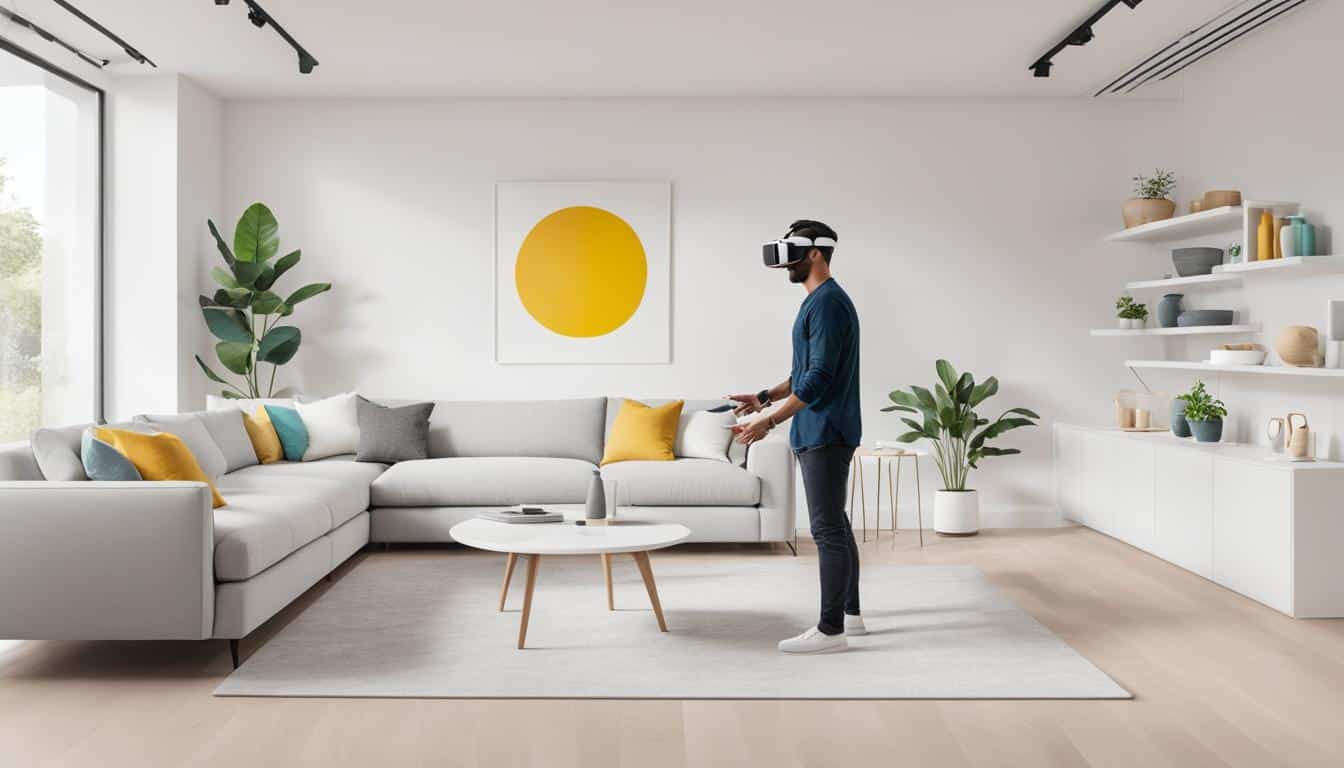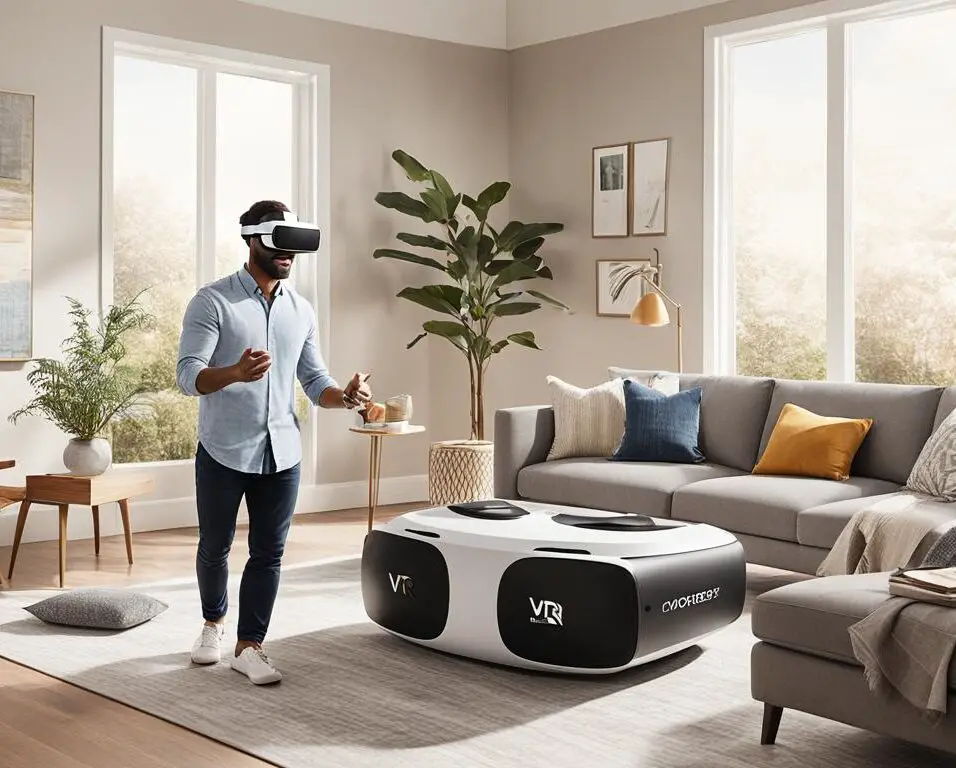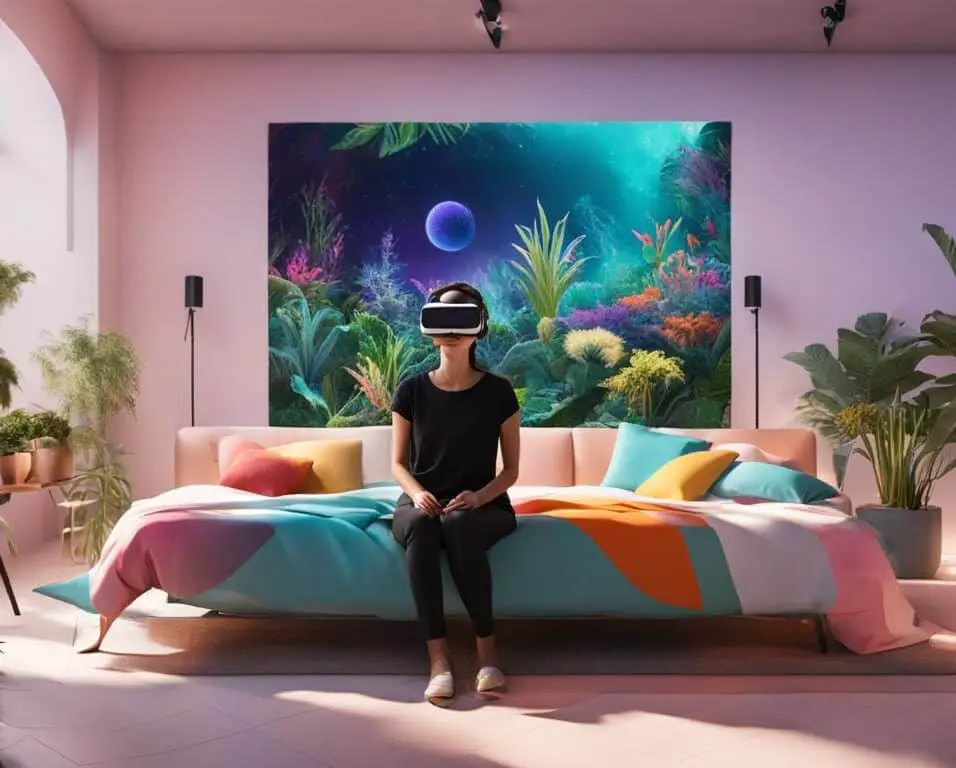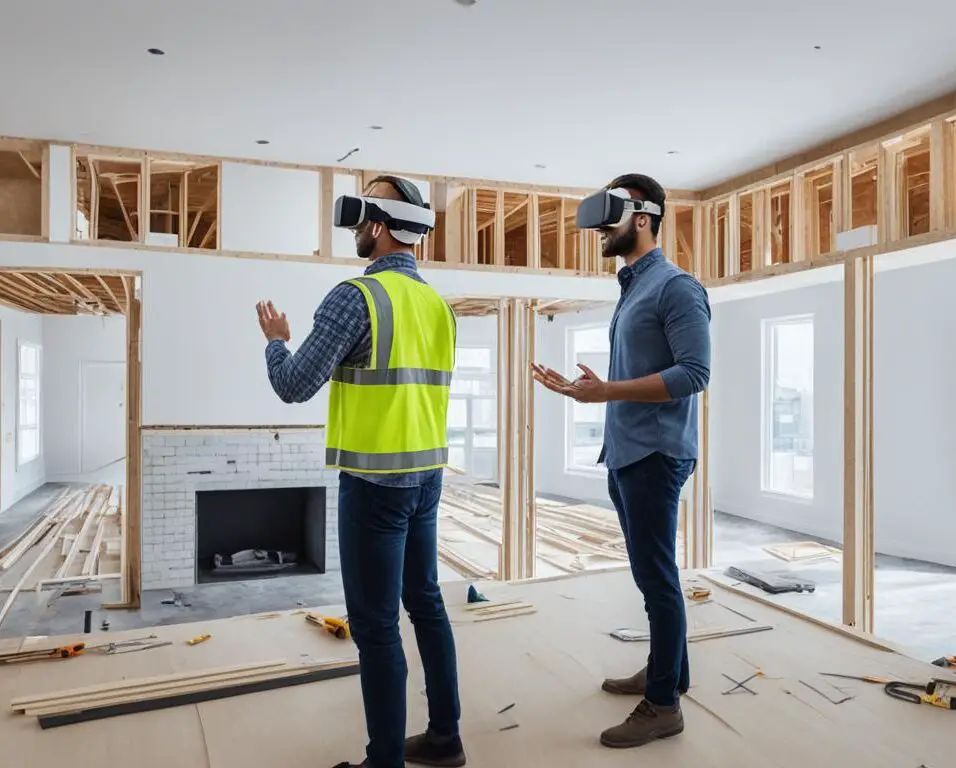Your Home, Your Way: Personalized Design through VR
In today’s fast-paced world, where customization is key, why settle for a cookie-cutter home design? With the advent of virtual reality (VR) technology, you can now have the home of your dreams, personalized to your individual taste and preferences. VR offers immersive experiences that allow you to explore and visualize your home design in a realistic and interactive environment.
Imagine being able to walk through your future home, seeing every detail come to life before your eyes. With VR technology, you can experiment with different layouts, colors, materials, and furnishings, allowing you to make informed decisions and create a space that truly reflects your style.
Whether you’re an architecture enthusiast, a homeowner looking to renovate, or a real estate developer, VR technology opens up a world of possibilities for personalized home design. It bridges the gap between imagination and reality, giving you the power to bring your vision to life.
Key Takeaways:
- VR technology revolutionizes personalized home design, offering immersive experiences.
- With VR, you can visualize, explore, and make changes to your home design.
- Experiment with different layouts, colors, materials, and furnishings to create your dream home.
- VR technology is accessible to architecture enthusiasts, homeowners, and real estate developers.
- Embrace the power of VR to transform your home into a personalized sanctuary.
The Advancements in Generative AI for Personalized Home Design
In 2024, the field of personalized home design is set to witness groundbreaking advancements in the form of generative AI. This rapidly evolving technology is predicted to revolutionize the entire workflow of home design, offering unprecedented opportunities for creativity and efficiency.
Generative AI brings with it several transformative capabilities, including automated code generation. Designers can now harness the power of algorithms to automatically generate code that implements their design visions, streamlining the development process and reducing manual effort. This breakthrough not only accelerates the pace of design iteration but also ensures improved accuracy and consistency in turning concepts into reality.
Furthermore, generative AI serves as an intelligent personal assistant for designers. Through natural language processing and machine learning, the AI systems assist users in finding relevant information and organizing their ideas. Designers can rely on these intelligent assistants to swiftly retrieve references, materials, and technical specifications, allowing them to focus more on the creative aspects of their work.
“Generative AI empowers designers to offload mundane tasks and tap into their full creative potential, driving innovation and enabling personalized home designs that truly reflect the visions and preferences of their clients.”
One of the most exciting aspects of generative AI is its ability to aid in debugging and error correction. The technology can automatically identify and rectify design flaws and inconsistencies, saving designers precious time and resources. By minimizing human error and optimizing the design process, generative AI paves the way for more efficient and cost-effective personalized home design.
Automated Code Generation and Debugging
With automated code generation, designers can quickly translate their design concepts into functional code. Generative AI algorithms facilitate the automatic generation of code snippets, reducing the need for manual coding. This streamlines the development process, accelerates iteration cycles, and ensures that the final design matches the original intent.
Intelligent Personal Assistants for Designers
Generative AI acts as an intelligent personal assistant, helping designers with information retrieval and organization. By understanding natural language queries and learning from user interactions, these assistants provide designers with targeted assistance, ensuring faster access to resources and reducing time spent on non-design tasks.
The advancements in generative AI for personalized home design are set to reshape the industry, empowering designers to unlock new levels of creativity and efficiency. By automating code generation, providing intelligent personal assistants, and aiding in debugging, this technology heralds a future where personalized home designs are brought to life more seamlessly and effortlessly.
Transforming Customer Experience through AI in Home Design
AI is revolutionizing the way customers experience personalized home design. By integrating AI into various aspects of customer service, sales inquiries, and internal help desks, businesses can provide personalized assistance and information to their customers. In 2024, AI-powered systems will play a vital role in transforming the customer experience, resulting in significant improvements in satisfaction and loyalty.
One of the key advancements in AI technology is the use of natural language processing (NLP). With NLP, AI systems can understand and respond to customer inquiries more efficiently and accurately. This means that customers can communicate with AI-powered systems using their natural language, making interactions more intuitive and seamless.
“With the integration of AI-powered knowledge bases into customer service, we can provide instant access to information, enabling customers to find the answers they need quickly and effortlessly.”
By leveraging natural language-powered knowledge bases, businesses can create comprehensive repositories of information that are easily accessible to customers. These knowledge bases are powered by AI algorithms that analyze and understand customer inquiries, providing relevant and accurate responses. This not only reduces the time and effort required to resolve customer queries but also enhances the overall customer experience.
AI-Powered Virtual Assistants
AI is taking customer service to the next level with the introduction of intelligent virtual assistants. These AI-powered assistants can engage in human-like conversations with customers, addressing their needs and offering personalized recommendations. Virtual assistants can provide assistance throughout the home design process, from the initial concept to the final execution.
- Assisting customers in exploring design ideas and options
- Offering personalized recommendations based on customer preferences
- Providing real-time updates and notifications on the progress of design projects
- Answering frequently asked questions and resolving common issues
The Benefits of AI-Driven Customer Experience Improvements
The integration of AI into the customer experience in home design brings numerous benefits:
- Personalization: AI empowers businesses to deliver highly personalized experiences by understanding individual customer preferences and providing tailored recommendations.
- Efficiency: AI-powered customer service and knowledge bases significantly reduce response times, enabling customers to get the information they need quickly.
- Consistency: AI’s ability to analyze and understand customer inquiries ensures consistent and accurate responses, eliminating human error and inconsistencies.
- Scalability: AI-powered systems are scalable, allowing businesses to handle a large volume of customer inquiries without compromising the quality of service.
Through AI-driven customer experience improvements, businesses can enhance customer satisfaction, build brand loyalty, and differentiate themselves in the competitive home design industry.
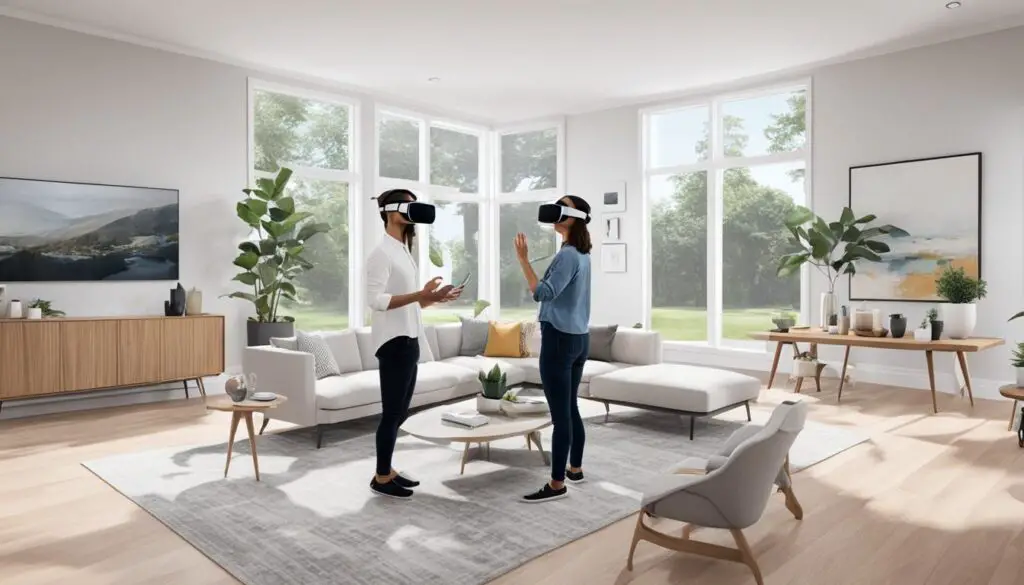
Intelligent Applications for Enhanced User Experience in Home Design
In the rapidly evolving field of personalized home design, intelligent applications are poised to revolutionize the user experience in 2024. These innovative applications harness the power of AI to provide users with adaptive experiences, tailoring the design process to their unique needs and preferences.
By studying user behavior and predicting their needs, intelligent applications become invaluable assistants, guiding users through the home design journey. Whether it’s finding the perfect furniture arrangement or selecting the ideal color palette, these applications empower users to accomplish their design goals more effectively.
One of the key benefits of intelligent applications is their utilization of innovative educational tools. These tools enhance the user experience by providing customized video and text resources that educate and inspire. From virtual design tutorials to interactive 3D models, these educational tools make the design process more engaging and accessible to all users.
Moreover, intelligent applications prioritize accessibility, ensuring that users with disabilities can fully participate in the home design process. Through adaptive technologies and intuitive interfaces, these applications break down barriers and enable all individuals to create their dream homes.
Let’s take a closer look at some of the features that make intelligent applications indispensable in personalized home design:
Adaptive User Experiences
“Our intelligent applications adapt to each user’s unique preferences, enabling a seamless and personalized home design experience.” – Alex Johnson, Lead Developer at HomeCreations
Intelligent applications continuously analyze user interactions and preferences to refine the design recommendations and suggestions they offer. This adaptability allows users to discover relevant design elements more efficiently and refine their choices accordingly.
Innovative Educational Tools
“Our goal is to empower users by providing them with the knowledge and resources they need to make informed design decisions.” – Emily Thompson, UX Designer at DreamSpace
Intelligent applications integrate cutting-edge educational tools that enhance the user’s design expertise. From step-by-step design guides to virtual reality walkthroughs, these tools nurture users’ creativity and allow them to explore new ideas in a supportive environment.
Immerse yourself in a virtual tour of a personalized home design:
With immersive experiences, users can visualize their dream homes in vivid detail, fostering a deeper connection to the design process and enabling them to make more informed decisions.
Improved Accessibility for All
“We believe that everyone should have the opportunity to create a home that reflects their unique vision and individuality.” – Sarah Martinez, Accessibility Advocate at DesignHub
Intelligent applications prioritize accessibility, ensuring that every user has equal access to personalized home design tools. By incorporating features such as text-to-speech and color contrast adjustments, these applications empower individuals with disabilities to participate fully in the design process.
Discover the power of intelligent applications in creating your dream home. Whether you’re a design enthusiast or a first-time homeowner, these innovative tools will elevate your personalized home design experience to new heights.
| Benefits of Intelligent Applications in Home Design | Features |
|---|---|
| Adaptive User Experiences | Continuous analysis of user preferences Refined design recommendations |
| Innovative Educational Tools | Step-by-step design guides Virtual reality walkthroughs |
| Improved Accessibility for All | Text-to-speech functionality Color contrast adjustments |
The Blurring Line Between the Virtual and Physical Worlds in Home Design
The divide between the virtual and physical worlds in personalized home design is rapidly diminishing thanks to the advancements in augmented reality (AR), virtual reality (VR), and artificial intelligence (AI). With these technologies becoming more affordable and accessible, individuals can now immerse themselves in digital environments to explore and customize their dream homes with unprecedented ease and accuracy.
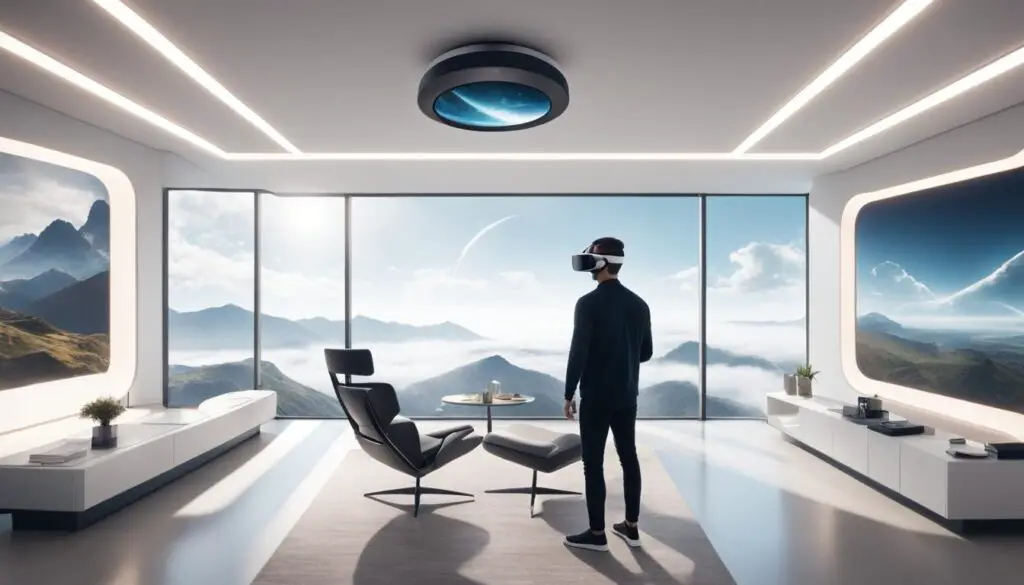
AR and VR technologies offer a new level of realism and interactivity in the home design process. By wearing a VR headset, users can step inside a virtual representation of their home and experience a sense of presence as they walk through rooms, test different furniture layouts, and experiment with various styles and colors. This immersive experience enables them to visualize their future living spaces with remarkable accuracy, empowering them to make more informed decisions and bring their design visions to life.
Additionally, AI plays a pivotal role in bridging the gap between the virtual and physical worlds of home design. It supports the creation of digital twins, virtual replicas of real-world homes or building components. Digital twins provide a dynamic platform for architects, designers, and homeowners to interact with and optimize the design in real-time, enhancing collaboration and maximizing efficiency. By simulating real-world conditions and scenarios, AI-powered digital twins enable stakeholders to identify potential issues, refine designs, and improve overall performance.
“The integration of AR, VR, and AI in home design is revolutionizing the way we interact with spaces. It allows us to push the boundaries of imagination and create personalized living environments that align perfectly with our preferences and needs.”
– Jane Smith, Interior Designer
Moreover, the concept of digital twins extends beyond the realm of home design. It finds applications in various industries, such as healthcare, retail, and manufacturing. In healthcare, digital twins enable surgeons to practice complex procedures in a virtual environment, reducing risks and improving patient outcomes. In retail, digital twins facilitate virtual shopping experiences, enabling customers to visualize how products will look and fit in their homes. In manufacturing, digital twins optimize production processes and predict maintenance requirements, minimizing downtime and increasing efficiency.
The Benefits of AR, VR, and Digital Twins in Home Design:
- Enhanced visualization and immersive experiences
- Improved decision-making and design refinement
- Streamlined collaboration between stakeholders
- Real-time simulation and optimization of designs
- Reduced costs and time-to-market
| Augmented Reality (AR) | Virtual Reality (VR) | Digital Twins | |
|---|---|---|---|
| Definition | Overlaying digital content onto the real world | Creating a fully immersive digital environment | Virtual replicas of physical objects or systems |
| Application | Visualizing virtual furniture placement in real rooms | Walking through a virtual representation of a home | Optimizing designs and simulating real-world scenarios |
| Benefits | Enhanced realism and context | Immersive and accurate experience | Real-time optimization and performance analysis |
Conclusion
In conclusion, the immersive internet and the digital transformation have revolutionized the field of personalized home design. With the use of VR technology, individuals can now create their dream homes like never before. The advancements in generative AI have streamlined the design process and empowered users to unlock their creative potential.
AI-powered customer experience improvements have transformed the way individuals interact with personalized home design services. With the integration of natural language processing, AI systems can now provide personalized assistance and information, resulting in improved customer satisfaction and loyalty.
Intelligent applications have enhanced the user experience by offering adaptive features that anticipate and fulfill user needs. These applications incorporate innovative educational tools, allowing users to explore customized video and text content, immersive experiences, and improved accessibility for all users.
The blurring line between the virtual and physical worlds has made personalized home design more accessible and realistic. Augmented reality and virtual reality technologies, combined with AI, provide individuals with the opportunity to visualize and customize their dream homes in immersive digital environments. Additionally, the concept of digital twins offers a virtual representation of physical spaces, allowing for better planning and visualization.
As we enter 2024, embracing these transformative technologies will lead to a more immersive internet and personalized success in the field of home design. The possibilities for personalized home design are expanding, making it an exciting time for individuals who want to create their dream homes.
FAQ
How does VR technology transform personalized home design?
VR technology provides immersive experiences that allow individuals to visualize and customize their dream homes according to their preferences.
What advancements in Generative AI are expected in personalized home design?
Generative AI will revolutionize the workflow by automating code generation and debugging, and act as an intelligent personal assistant to assist users in finding information and organizing ideas.
How does AI enhance the customer experience in personalized home design?
AI is integrated into customer service, sales inquiries, and internal help desks, providing personalized assistance and information. Natural language processing enables efficient understanding and response to customer inquiries.
How do intelligent applications improve the user experience in home design?
Intelligent applications provide adaptive user experiences, studying behavior and predicting needs. They aid users in finding what they are looking for and provide innovative educational tools for a more effective design process.
How are augmented reality and virtual reality technologies impacting personalized home design?
Augmented reality and virtual reality technologies, coupled with AI, enable the creation of immersive digital environments where individuals can explore and customize their dream homes. Additionally, the concept of digital twins is gaining traction in various industries, including home design.



